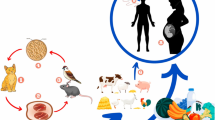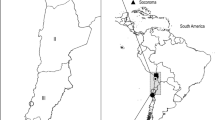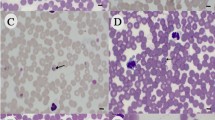Abstract
Babesiosis is a lethal protozoan disease, responsible for the loss of livestock in Iran and in the world. The purpose of the current study was to detect and identify Babesia spp. infection using microscopic and molecular methods in human, sheep and goats in Kuhdasht region, in the Lorestan Province, west of Iran. During 2013, a total of 384 blood smear samples were collected from 51 goats, 306 sheep suspected of Babesiosis infection and 27 humans from Kuhdasht region. The blood samples were fixed, stained and under light microscopic examined. DNA samples were extracted and amplified by polymerase chain reaction of 18S-rRNA gene. PCR and the semi-nested PCR were performed to identify to Babesi spp. and to differentiate genus of Theileria and Babesia spp. The results of microscopic examination indicated that a total of 47 (12.2%) samples were positive for Babesia spp. infection: 38 (9.9%) belonging to sheep and 9 to goats (2.3%). No Babesia was observed in human samples. The PCR showed a band size of 389 bp, of Babesia spp. and the semi-nested PCR detected B. ovis with a band size of 186 bp. By molecular method, 16 (4.2%) sheep and 2 (0.5%) goat blood samples were infected by Babesia. Totally, 18 samples (4.7%) were observed to have Babesia, while no infection was found in human. Thus, the results of our study have shown sheep and goats could be vulnerable to Babesia spp., especially B. ovis in Lorestan Province, Iran. Therefore, studies on the status of the animal Piroplasmosis especially Theileriosis are recommended.


Similar content being viewed by others
References
Alani AJ, Herbert IV (1988) The pathogenesis of Babesia motasi (Wales) infection in sheep. Vet Parasitol 27:209–220
Almeria S, Castella J, Ferrer D (2001) Bovine piroplasma in Minorca (Balearic Island, Spain): a comparison of PCR based and light microscopy detection. Vet Parasitol 99(3):249–259
Anwar M (1974) Geographical distribution of blood protozoan parasites of ruminant in Iran. Bull Off Int Epiz 81(9–10):793–798
Askarian M (1996) Babesia bodies overview of the human and animal. Dissertation, Veterinary Faculty of Tehran University [Full text in Persian]
Bashiri Bod H (1993) Human pathogenic parasites, chapter IV: the blood, 2nd edn. Tehran University Press, Tehran, pp 145–147
Centeno-Lima S, Do Rosario V, Parreira R, Maia AJ, Freudenthal AM, Nijhof AM, Jongejan F (2003) A fatal case of human babesiosis in Portugal: molecular and phylogenetic analysis. Trop Med Int Health 8:760–764
Delpy RLP (1936) Agents en Iran dans le sang des animaux domestiques. Bull Path Exot 29:157–161
Fischer M (2008) Manual of tropical veterinary parasitology. CAB Int Lond 2:16–20
Gabrielli S, Calderini P, Cassini R, Galuppi R, Tampieri MP, Pietrobelli M, Cancrini G (2014) Human exposure to piroplasms in Central and Northern Italy. Vet Ital 50(1):41–47
Gholami S, Laktarashi B, Shiadeh MM, Spotin A (2016) Genetic variability, phylogenetic evaluation and first global report of Theileria luwenshuni, T. buffeli, and T. ovis in sheepdogs in Iran. Parasitol Res 115(5):2125–2130
Gorenflot A, Moubri K, Precigout E, Carcy B, Schetters TP (1998) Human babesiosis. Ann Trop Med Parasitol 92:489–501
Gubbels JM, de Vos AP, Van der Weide M, Viseras J, Schouls LM, deVries E, Jongejan F (1999) Simultaneous detection of bovine Theileria and Babesia species by reverse line blot hybridization. J Clin Microbiol 37:1782–1789
Habela M, Reina D, Nieto C, Navarrete I (1990) Isolation and identification of Babesia ovis in Extremadura (Spain). Vet Parasitol 35:233–238
Habibi GR, Hashemi–Fesharki R, Bordbar N (2004) Detection of Babesia ovis using polymerase chain reaction. Arch Razi Inst 57:1–10
Hashemi Fesharaki R, Uilenberg G (1981) Babesia crassan. sp. (Sporozoa, Babesiidae) of domestic sheep in Iran. Vet Q 3(1):1–8
Heidarpour Bami M, Khazraiinia P, Haddadzadeh HR, Kazemi B (2010) Identification of Theileria species in sheep in the eastern half of Iran using nested PCR-RFLP and microscopic techniques. Iran J Vet Res 11(3):262–266
Kjemtrup AM, Conrad PA (2000) Human babesiosis: an emerging tick-borne disease. Int J Parasitol 30(12–13):1323–1337
Kjemtrup AM, Thomford J, Robinson T, Conrad PA (2000) Phylogenetic relationships of human and wildlife piroplasm isolates in the western United States inferred from the 18S nuclear small subunit RNA gene. Parasitology 120(5):487–493
Michael R, Fibin MD, Eleftherios E, Mylonakis MD, Callegari L, Eric Legome M (2001) Babesiosis. J Emerg Med 20:21–24
Motavalli Haghi SM, Fakhar M, Sharif M, Paghe A, Sharbatkhori M, Tavakoli R, Gholami SH (2013) Molecular identification of ovine Babesia spp. in north of Iran. Res Mol Med 1(1):35–39
Nayel M, El-Dakhly KM, Aboulaila M, Elsify A, Hassan H, Ibrahim E, Salama A, Yanai T (2012) The use of different diagnostic tools for Babesia and Theileria parasites in cattle in Menofia, Egypt. Parasitol Res 111(3):1019–1024
Noaman V (2013) A molecular study on Theileria and Babesia in cattle from Isfahan province, Central Iran. J Parasit Dis 37(2):208–210
Rafiei H (1966) Veterinary and comparative protozoology. Publications of the Ministry of Science and Higher Education, pp 144–155, 649–709
Ranjbar-Bahadori S, Eckert B, Omidian Z, Sadr Shirazi N, Shayan P (2012) Babesia ovis as the main causative agent of sheep Babesiosis in Iran. Parasitol Res 110:1531–1536
Razmi GR, Naghibi A, Aslani MR, Fathirand M, Dastjerdi K (2002) An epidmiological study on ovine babesiosis in the Mashhad suburb area province of Khorasan. Vet Parasitol 18(2):109–115
Razmi GR, Naghibim A, Aslani MR, Dastjerdi K, Hossieni H (2003) An epidemiological study on Babesia infection in small ruminants in Mashhad suburb, Khorasan Province, Iran. Small Rumin Res 50:39–44
Renneker S, Abdo J, Bakheit MA, Kullmann B, Beyer D, Ahmed J, Seitzer U (2013) Coinfection of sheep with Anaplasma, Theileria and Babesia species in the Kurdistan Region, Iraq. Transbound Emerg Dis 60(l 2):113–118
Shayan P, Rahbari S (2005) Simultaneous differentiation between Theileria spp. and Babesia spp. on stained blood smear using PCR. Parasitol Res 97:281–286
Shayan P, Rahbari S (2007) Differentiation of sheep Theileria spp. and Babesia spp. by polymerase chain reaction. J Vet Res 62(2):15–20
Shayan P, Hooshmand E, Nabian S, Rahbari S (2008) Biometrical and genetical characterization of large Babesia ovis. Parasitol Res 103(5):217–221
Skrabalo Z, Deanovi Z (1957) Piroplasmosis in man: report on a case. Doc Med Georgr Trop 9(1):11–16
Tavassoli M (1998) Seroepidemiological study of Babesia ovis in sheep in different climatic regions of Iran, using indirect immunofluorescent test (IEAT). Ph.D. thesis on parasitology, Faculty of Veterinary Medicine, Tehran University, Iran
Acknowledgements
This article is derived from the Master’s thesis of the first author (Arash Naderi). We thank Bahran, Lak Tarashi and Mehdi Mehr Ali Nejad, Molecular Lab Smsmam Tour Veterinary Research Center, Sari, Iran and staff of Parasitology Department of Mazandaran University of Medical Sciences for their collaboration.
Author information
Authors and Affiliations
Corresponding author
Ethics declarations
Conflict of interest
The authors declare that there is no conflict of interest.
Rights and permissions
About this article
Cite this article
Naderi, A., Nayebzadeh, H. & Gholami, S. Detection of Babesia infection among human, goats and sheep using microscopic and molecular methods in the city of Kuhdasht in Lorestan Province, West of Iran. J Parasit Dis 41, 837–842 (2017). https://doi.org/10.1007/s12639-017-0899-1
Received:
Accepted:
Published:
Issue Date:
DOI: https://doi.org/10.1007/s12639-017-0899-1




